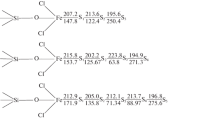Abstract
A qualitative algorithm for construction of large clusters of silica gel model structures is used. According to this algorithm and in line with our classification of dispersive silicas, silica gel is regarded as cyclosilica, which is characterized by loose packing of the cycles of silicon-oxygen tetrahedra. A model of silica gel structure is proposed, where the primary structural fragments are hollow frameworks with a network surface. The units of the surface network are formed by nonplanar [SiO4] chain cycles of various sizes. This structural model makes it possible to explain the peculiarities of the vibration spectra of the framework, hydroxyl, and aqueous components of silica gels.
Similar content being viewed by others
References
V. D. Khavryuchenko and E. F. Sheka,Zh. Struk. Khim.,35, No. 2, 74–84 (1994).
V. D. Khavryuchenko and E. F. Sheka, ibid., No. 3, 16–26.
I. V. Markichev, I. Natkanets, and E. F. Sheka, ibid.,33, No. 1, 64–76 (1993).
E. F. Sheka, I. V. Markichev, I. Natkanets, and V. D. Khavryuchenko, ibid.,33, No. 4, 39–51 (1993).
T. Clark,A Handbook of Computational Chemistry: A Practical Guide to Chemical Structure and Energy Calculations, Wiley, New York (1985).
I. E. Neymark and R. Yu. Sheinfine,Silica Gel: Production, Properties, and Applications [in Russian], Naukova Dumka, Kiev (1973).
F. Liebau,Structural Chemistry of Silicates, Springer-Verlag, Berlin (1985).
V. A. Zaets,CLUSTER-Z1 Computational Chemistry Package [in Russian], Inst. Surf. Chem., Ukr. Acad. Sci. (1990).
E. Sheka, V. Khavryuchenko, I. Natkanets, et al.,Physica B,174, 182–186 (1991).
E. F. Sheka, ibid., 227–232.
Additional information
Institute of Surface Chemistry, Ukrainian Academy of Sciences. Russian University of Peoples' Friendship. Translated fromZhurnal Strukturnoi Khimii, Vol. 35, No. 3, pp. 27–34, May–June, 1994.
Translated by O. Kharlamova
Rights and permissions
About this article
Cite this article
Khavryuchenko, V.D., Sheka, E.F. Computational modeling of amorphous silica. 3. Modeling the initial structures. Silica gel. J Struct Chem 35, 299–304 (1994). https://doi.org/10.1007/BF02578280
Received:
Issue Date:
DOI: https://doi.org/10.1007/BF02578280




